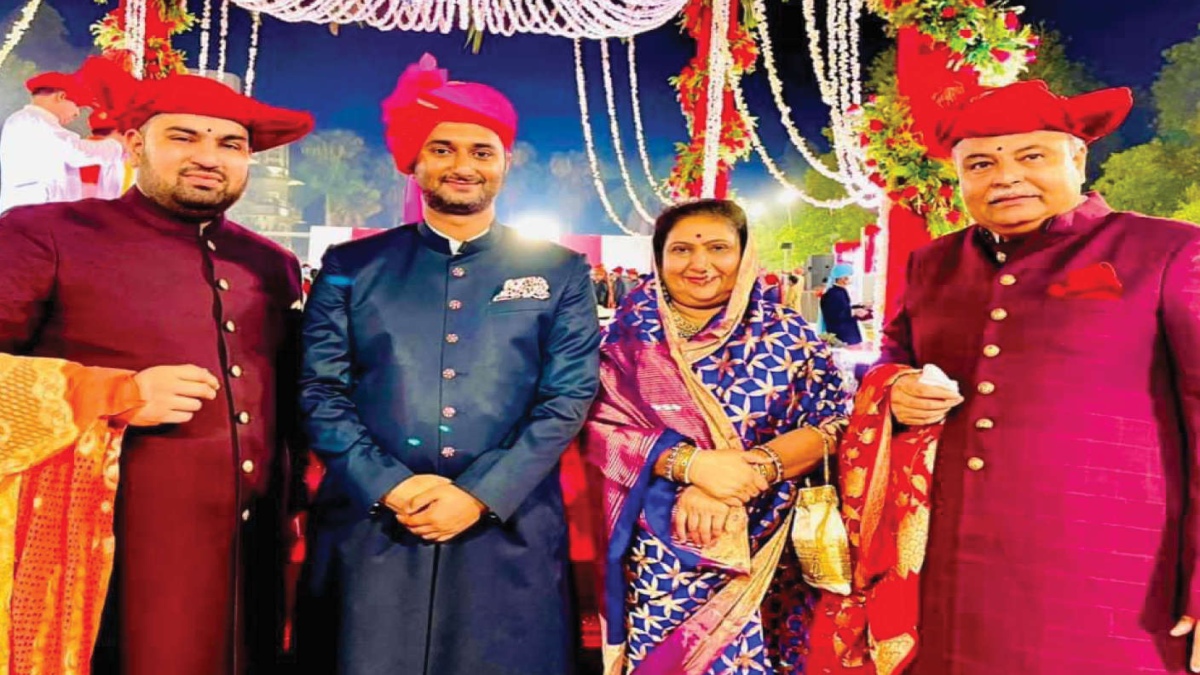


Indian royalty has always been known for its lavish splendour. Sardar Kumar Daulat Mahadik, son of Sardar Yashwantrao Mahadik of Gwalior state, tied the knot with Sau. Chi. Kan. Kirtiraj, daughter of Sardar Shrimant Sharadrao Chavan Himmat Bahadur, a prominent family in the Nagpur state.
 Ambika Raje Ghorpade Sandur with lady Uma Devi Raje Jadhav.
Ambika Raje Ghorpade Sandur with lady Uma Devi Raje Jadhav. Groom and bride.
Groom and bride. Sardar Yashwant Rao Mahadik and Vrushali Raje Madaik with Rajamata Gayatri Raje Puar.
Sardar Yashwant Rao Mahadik and Vrushali Raje Madaik with Rajamata Gayatri Raje Puar. The Mahurkars with Yuvraj Divyaraj Singh of Rewa.
The Mahurkars with Yuvraj Divyaraj Singh of Rewa. Sardar Vikramaditya Phalke with the groom and HH Maharaj Vikramsinh Puar of Dewas.
Sardar Vikramaditya Phalke with the groom and HH Maharaj Vikramsinh Puar of Dewas.
Mahadik comes from a leading Sardar family of Gwalior. The marriage was a holy union of two souls and their noble families. The wedding, which was held on 4 July, turned out to be a meeting place for premier royal and Maratha Sardar families across India. Among those who attended were Karthik Raje and Ambika Raje of Sandur and Yuvraj Sri Divyaraj Singh of Rewa.
The Gwalior state once boasted of some of the biggest Sardars (Jagirdars) in India during the princely era. Prominent Maratha nobilities which attended the wedding were Sardar families of Gwalior including Phalke, Bhonsle, Patankar, Mahurkar, Kadam, Gujar and Awad, besides members of prominent Sardar families of Maharashtra including Naik Nimbalkar of Phaltan and Bhope Kadam of Kolhapur and royal family of Dewas, Madhya Pradesh.
The centuries-old wedding traditions involving the Sardar families took place at Taj Usha Kiran Palace, a heritage hotel and the former annexe of Scindia dynasty’s Jai Vilas Palace.
The guests witnessed the elaborate ceremony which was followed by a reception. The festivities began with a Grand Haldi Ceremony in which the groom was most elaborately dressed in the royal Maratha jari Angrakha and the stylish Gwalior pagri; he was greeted by the bride’s family with gifts, the festivities winding up with a reception on the second day.
At the wedding, the bride was welcomed with flowers and diya aarti by Dr Anushkaraje Mahadik and Princess Kanika Raje Puar, the sisters-in-law.
The wedding ceremony began with the Maratha Mangalashtak ritual in which the couple facing each other with a muslin cloth in between took the wedding vows amid mantras and shlokas chanted by the pandits. According to the unique Maratha customs, the groom’s mother had to keep away from the Mangalashtak ceremony.
The royal wedding celebrations were spread over two days, with the Haldi and Cocktails on 3 July, and a Maratha-style Kelwan, a traditional sit down luncheon in ornate silver cutlery. All the celebrations were held at Taj Usha Kiran Palace. Sardar Yashwantrao Mahadik (father of the groom) is a seasoned global HR professional with over 29 years of experience in top-notch multinational corporations. He is also an avid wildlife photographer with a captivating collection of pictures.
The Maratha women in the wedding wore the most spectacular Chanderi and Maheshwari sarees that were immortalised by royal Maratha figures like Rani Ahilyabai Holkar and Maharani Chimnabai of Baroda. The men wore pagris, made from stretched and starched Chanderi, the pugri of one state being unique from the other. They wore royal angarkhas, resplendent with regal and precious buttons. I had the great fortune of attending this wedding.
The Sardar Mahadik clan had played a significant role in establishing Maratha power in north India under the great Mahadji Scindia. Along with other Sardar families including Sardar Mahurkar family, it played a pivotal role in tracking down and then punishing the barbaric Rohilla chief Glulam Kadir who had gorged out the eyes of Mughal emperor Shah Alam-II with horrid cruelty in 1788.
The Himmat Bahadur Chavan clan is also a premier Maratha clan of Maharashtra whose ancestors had fought relentlessly against Aurangzeb after Chhatrapati Shivaji’s demise and ultimately helped in reducing the Mughal power and holding the Maratha flag aloft in the southern India
Even today the Marathas are known for their rooted and resplendent medieval traditions.